
Welcome, from sunny Australia!
Other Stuff

Other Stuff
- A good way to fit the sump so it won't leak is to coat the block flange with a reasonable coating of silicone sealant, then fit it to the block and then do up the retaining bolts with only your fingers. Leave it for a couple of days, then finish the job with a tension wrench. (Also make sure the sump flange is straight; It makes the job so much easier) If the sump plug is looking a bit daggy because it's only ever been molested by a cheap shifting spanner, then while it's out weld a large nut to the head of it so you've got a nice, large surface to grip next time. The same applies for the gearbox and diff sump plugs, of course.
-The oil pump can be made to work far better by taking to it with a very fine grinder or a small file. Take off all the sharp edges that the oil has to slip around, thus making it easier to suck & push around and giving the engine more power. (You'd be amazed how much power the oil & water pumps take to drive) Make sure all the sealing surfaces are straight and true - You may need to spend some time on a fine grindstone to tighten things up again. The oil pump will have a pressure relief valve with a spring in it. You can boost your oil pressure by putting a 1/16" washer behind the spring. Some pumps may need more, some less; They are all different, depending on what the engine needs.
 |
 |
 |


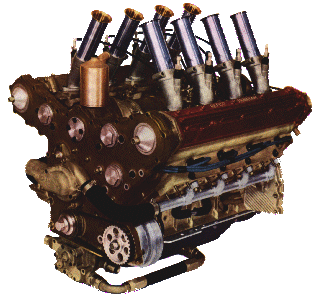
The mighty Aussie-built Formula One Repco
Brabham engine! ~420hp. Developed in the late 60's,
and it & the Brabham car are the only owner/builder type cars ever to win
the World Championship
- Quite often the head gaskets supplied
aren't so good when it comes to lining up with all the water passages -
Take the time to carefully check them all out and if needed trim the
holes with a sharp knife so they match the outer edges of the largest
hole in question. Sometimes oil return holes as well. It does pay to be
careful though, as some head gaskets are deliberately designed to have
smaller water passage holes in them that what is in the head and/or
block. This is done to try to keep the water from leaving that part of
the head too quickly, and thus picking up the heat from the head
effectively. It's actually not uncommon to find this sort of thing on an
engine that's grown in capacity from a smaller original one.
Copper head gaskets are also often used on high-power turbo engines.
They also normally use O-rings to seal the combustion chamber pressures.
If you use a copper head gasket, then both the block and head mating
surface must be extremely smooth & flat or the gasket will not seal.
Here's a 4AGE copper head gasket.
- Trimming weight off the flywheel is a great
benefit. The only problem is that with some factory flywheels it isn't
safe to cut a lot out of them, and so you'd be better off doing it
properly by getting an alloy one fabricated from scratch. In both cases,
you want the minimum of metal around the edges of the flywheel so as to
reduce rotational momentum. If you can, have just enough metal
to support the ring gear for the starter to run on and nothing else.
Alloy flywheels will need a steel insert for the clutch plate to run on;
The flywheel won't last very long otherwise. If you do reduce the weight
of the original flywheel, then after balancing get it shot peened.
Change the flywheel bolts every rebuild on a performance engine, or on
a standard type engine every second time. Here's one of my 4AGE alloy
flywheels.
- Sparkplugs & leads & coils can
make a small difference, but only a few hp or so. The easiest way to
pick what sparkplug you need is to simply go one heat range cooler than
standard. The best plugs seem to be the ones with the copper cores and
'U' shaped electrodes. As for how long they last - When the car is
getting even slightly hesitant to start in the mornings, change them. Don't
redo the gap or clean them, just throw them away a put a new set
in. Sparkplug lead efficiency depends on how much electricity the lead
lets get to the sparkplug, and how much gets radiated away into the
other leads (Causing mis-fires sometimes) and people's radios. The coil
can make a difference, so it's worth getting a good one. How to tell if
you've got a good one? How far the spark jumps is a good sign, I reckon.
There are many brand name coils that are very expensive, but I am quite
happy to run one of the newer type of coils that's shaped like a
electrical transformer. They have a pretty healthy spark and are cheap
enough to have a spare lying around.
As has been said more than once, "bang for
buck, ignition systems add-ons are the worst." Just make sure that
what you have is in top condition and you can't go wrong.
- Synthetic oil is the only way to go. No excuses! The only thing to check is to see that it is in fact a full synthetic, not a blend like the early Mobil One was. (Now a full synthetic though) They last longer, protect better, and make more power than mineral oils.
- Oil filters vary in quality quite a bit, but if you have a Toyota you're laughing - They are expensive but the best for your engine and are quite good enough to go racing with. Oil filters either come with a bypass valve or they don't - The bypass valve is there in case the pressure differential (Between the incoming and the outgoing oil) in the filter gets so high, possibly because of debris blocking the filter, that some oil, dirty as it may be, will still get to the engine. This is not a good thing for performance engines. At high revs, it's possible to get so much oil flow that the bypass valve will open anyway and so the oil is not being filtered! If you take the time, it is possible to get a filter for your engine that doesn't have a bypass valve. The only thing you must be careful of is to take great care in warming up the engine before running it at high revs. (It takes me at least 15 minutes on an average day to warm the engine before I'll rev it hard) One small trick some people use it to fit an adjustable clamp (The sort that's made from metal and adjusts in & out with a screwdriver) around the filter base to stop it from blowing a side out.
- Superchargers are great for making lots more power quickly. They give the engine immediate response, unlike a turboed engine, and also a lot more power at low revs. They are, however, a bit of a compromise to set up. If you want lots of power at low revs, you need to spin the blower quickly, vice-versa for higher revs. But, the faster you spin the thing, the more power it sucks from the engine. Ok, it compensates by making lots of boost, but the power required to drive the thing goes up something like the square of the rpm of the engine, so even if you have set the thing up to make boost at high revs, all things being equal a turbo engine that is making the same amount of boost will make more power. The other problem they sometimes have is that if you spin the rotors too fast then it's possible that on certain types (eg, Toyota) the tips of the rotors (which are made from a form of teflon plastic to help seal the air behind the tips) will start to melt.
- Turbo's are a real blast, and a turbo
engine is ever so easy to get more power from, simply by upping the
boost. A couple of basic rules for turbo's - The bigger the dump pipe
from the turbo's turbine housing the less backpressure you'll have and
so the earlier the turbo will spin up in the engine's rev range. A more
efficient intercooler is always good. I say 'more efficient' instead of
'bigger', because in the quest to fit a bigger intercooler the air
plumbing can often get all too long and so cause excess lag when wanting
boost. To make an intercooler more efficient, you have to get more
airflow through it and so that often means bigger scoops, etc, to get
the air moving through it. What a lot of people forget is that the exit
from the intercooler is just as important as the entry, so the airflow
is still not as good as what it should be. One possible solution is to
use a water-to-air intercooler, as they are often more flexible with the
installation and still provide good cooling. They're also a lot better
around town where you often don't get a lot of good, clean, cool,
airflow.
If you're going to add a blow-off valve to
the turbo engine, then don't expect any noticeable improvement in
performance. The vast majority of installations don't make the car
faster at all; they just sound faster. ;) If your engine is a MAP
sensed one then you can vent the blow-off valve to atmosphere no
problems, but if you have an AFM'd engine them you must vent the
outflowing air back into the inlet system between the AFM & throttle
butterfly. The reason for this is when the blow-off valve opens it'll
let a lot of air still pass through the AFM, which then signals the
computer that the engine is still making a lot more power than what it
actually is, so, the computer makes the engine run waaaay too rich and
it'll blow clouds of black smoke out the exhaust.
- You'll often hear of long-stroke
engines 'making more torque' than short-stroke. This is wrong, stroke
has little to do with the generation of torque, it's almost purely the
capacity of the engine. Consider two cylinders, one with a long
stroke/small bore and the other with a short stroke/big bore but both
having the same capacity. If you apply the same (combustion) pressure
to the top of each piston then the instantaneous torque on the
crankshaft will be exactly the same.
Here's the proof, take a ...
4" bore 3" stroke (37.68 cu") and put 1,000psi on the top of the piston
with the crankshaft sitting at 90°. The piston area works out to
(2^2 x 3.14159 = ) 12.56sq inches so 1,000psi on top of that = 12560lbs
acting on a 3" arm = 3140ft-lbs.
2" bore 12" stroke (37.58 cu") still with 1,000psi, etc. Piston area is
3.14159 sq inches so 3,141 lbs on a 12" arm - 3141ft-lbs or practically
exactly the same torque. (Note that these are just instantaneous
figure, the engine won't really make that much torque when running)
The benefit of the shorter stroke/big bore is that you can fit larger
valves for better breathing, lose less friction for any given revs due
to the lower piston speed, and rev the engine harder due to the lower
piston speed. The con-rods will also likely be longer and that too is a
useful benefit for the majority of engines.
- Which is better, a 2.5 litre
four-cylinder engine or a 2.5 litre six-cylinder? Most people
automatically poo-poo the four-cylinder engine but as I just
demonstated above the bigger the bore the better for breathing.
True enough then the six should have a shorter stroke and that's
also a good thing .... so which is best? Even though the four will have
bigger bores and so breath quite well, the six will actually have more
total valve area, and here's the maths behind it.
A reasonable general assumption is that for a four-valve engine the
inlet valves will be about 1/3 the diameter of the bores. If we give
the four-cylinder engine a 100mm bore (like a Subaru 2.5 litre EJ25)
and the six-cylinder an 86mm bore (like the Toyota 1JZGE) then the
valves work out to 33.3mm and 28.6mm respectively. The four will have a
total of eight 33.3mm valves or a total of 6967sqmm. The six will have
a total of twelve 28.6mm valves or a total of 7709sqmm.
So the six will be better in terms of breathing ability, but it will be a heavier & longer engine.
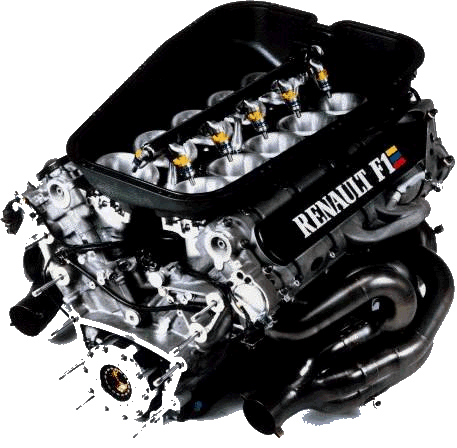
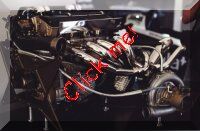
A BMW Formula One 1.5 litre turbo
racing engine. In excess of 1,000hp at the wheels and the BMW engineers
reckon they had about 1300hp in qualifying trim which is rather healthy
to say the least.
This is a fairly rare photo - It's a 1995 to 1996 (I think) Illmor/Mercedes 2.65 litre V-8 Indycar cylinder head. You can see the inlet ports pretty clearly here, and perhaps surprisingly they are still bifurcated this far out of the inlet valves. If you look carefully you can see the sides of the cam buckets are cut away to allow for very high lift cam lobes to pass. These engine are required to use conventional coil springs instead of the more advanced pneumatic valve springs that the Formula One engines use.
Speaking of pneumatic valve systems, this is a basic diagram of how they work
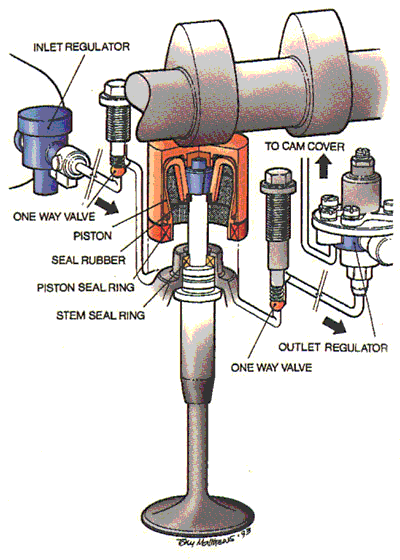

Also of interest is the 1986
(?) Honda RA168E twin-turbo V-6 1.5 litre Formula One engine. It was
rated at 'only' 685hp, but with the rules & restrictions at that
time it was heavily derated. (Note the BMW engine of a couple of years
before!) You can see the extremely strong con-rods, crank, pistons, etc,
that help it stay together at high revs and a fair old amount of boost.

This is supposed to be the actual power figures from a 2000 spec Ferrari Formula
One engine. I don't know how accurate it is, but I think
it'd be pretty close.
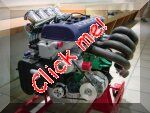 |
 |
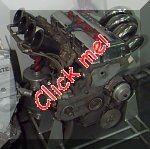 |
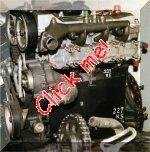 |
These Toyota engines are interesting. The one on the left is the very rare 1.3 litre 3K-R twin cam 16 valve racing engine. I don't know how many were made but it appears there was only a small handful. Note the mechanical fuel injection & slide throttles. The second engine is the 1.6 litre 16 valve twin cam 2T-G racing engine, also very rare. (I've seen one though, at the 1984 Bathurst 1000 in Aus, at the Toyota tent). The third engine is a 2.0 litre 16 valve 18R-G racing engine. I took that photo at a performance shop in Los Angeles. At the same shop was the engine at the far right, which is the 2.2 litre '503' engine, and it's not developed from any commercial Toyota engine. It's loosely based on the 3SGTE, but has no common parts. It was mainly intended to run at the famous US Pikes Peak Hillclimb, but Toyota have also used them a fair bit in various sports cars. They make around 900hp odd running on methanol.
Continue on to -
Other Tuning - Further reading and race car sounds
For more motorsport links, try the motorsport section on my links page.
Back to the Index page
Page & contents where applicable © Bill Sherwood